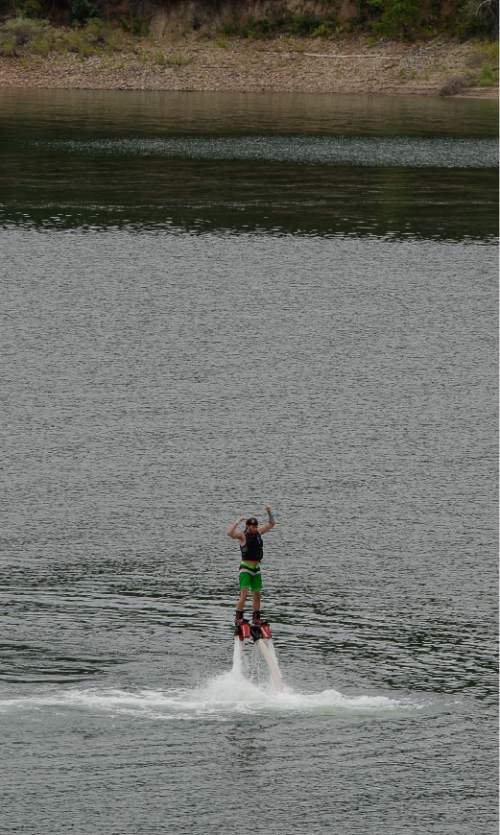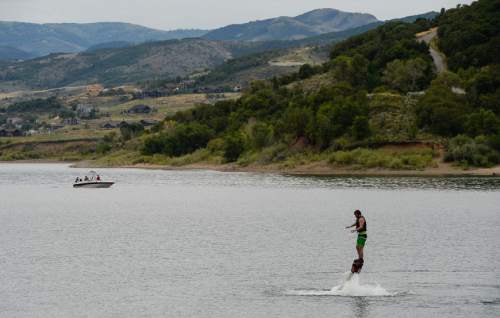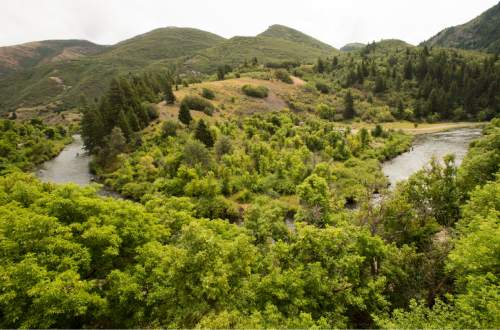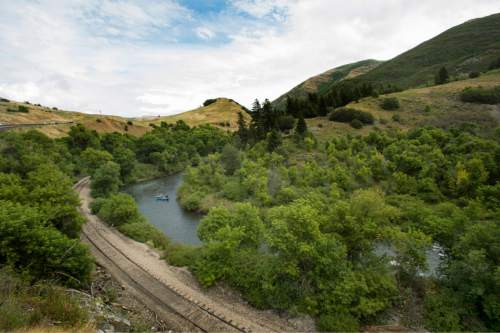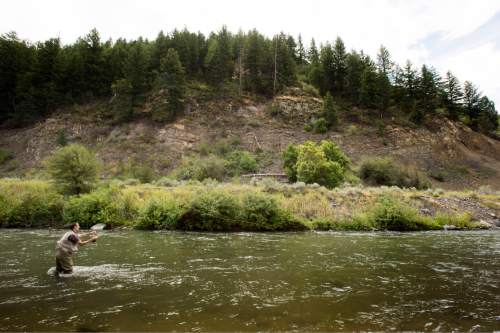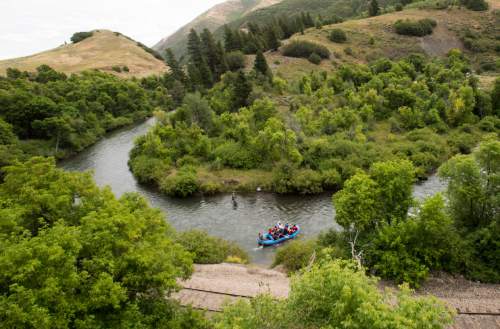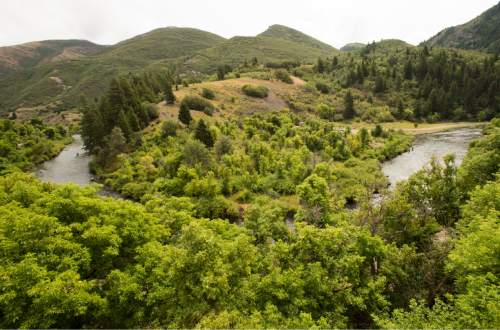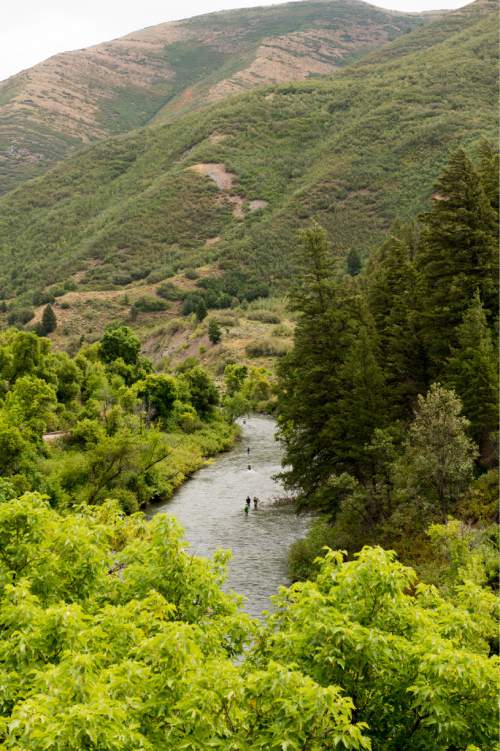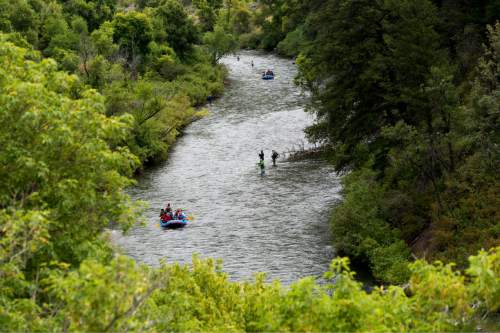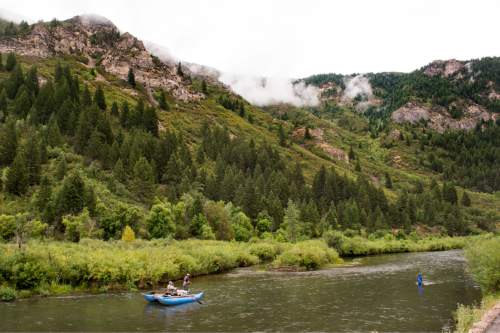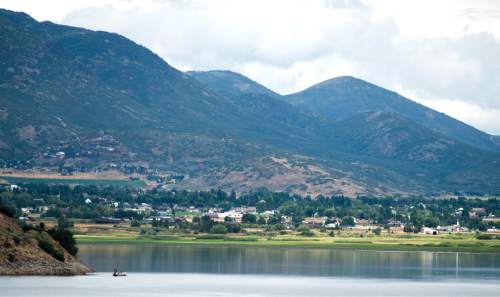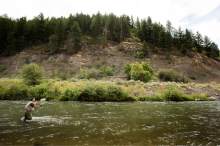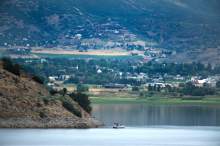This is an archived article that was published on sltrib.com in 2015, and information in the article may be outdated. It is provided only for personal research purposes and may not be reprinted.
Three of Utah's largest public drinking-water systems tap reservoirs that are known to develop toxic algal blooms.
But they aren't the only water bodies with algae problems. More than 20 Utah rivers, lakes and reservoirs have developed dangerous bright-green vegetation.
A potentially toxic algae plume prompted Herriman leaders to close popular Blackridge Reservoir late Thursday. And last week, a Utah Department of Health report said the state veterinarian determined toxins from a Utah Lake algae plume likely killed two dogs last fall.
In response to a Salt Lake Tribune public-records request, the Utah Division of Water Quality (DWR) this week released a list of water bodies with algae problems.
Half the lakes and reservoirs affected are used as drinking-water sources.
State regulators say the public has no reason to worry: New guidelines and a decades-old agreement to address water quality concerns proactively, should keep residents safe.
"It's not that we don't pay attention to those water bodies," said Eva Nieminski, an environmental engineer with the Utah Division of Drinking Water. "Preventative measures that we have, plus the regulations in place, are protective of public health."
Public drinking water systems that serve residents in Ogden, Salt Lake City and Utah County all collect water from reservoirs that are considered vulnerable to potentially harmful algal blooms.
Twenty-one Utah lakes and reservoirs have developed toxic algal blooms — overpopulations of certain algae and bacteria that release toxins that can harm or kill humans and other animals — and are considered vulnerable to future blooms, according to the DWR list.
Utah County's Central Utah Water Conservancy District had the highest number of at-risk waters on the list. State water quality regulators have documented toxic algal blooms at four of the district's drinking water sources — the Provo River, Steinaker Reservoir, Red Fleet Reservoir and Starvation Reservoir.
Blooms also have been found in Deer Creek Reservoir, which supplies drinking water for Salt Lake residents, and Pineview Reservoir, which serves Ogden residents.
While algal blooms pose the most risk to people and animals exposed directly to the algae while recreating, the blooms have been known to threaten drinking water supplies in other parts of the country. A severe bloom in Toledo, Ohio last year forced the city to cut water service to 500,000 residents.
But that isn't likely to happen here, said Nieminski, who also coordinates the Utah Water Quality Alliance.
Toledo shut down water service during the algal bloom because the city's distribution system already was compromised before the algal bloom began, Nieminiski said. Under normal circumstances, she said, it would be very difficult for the algae or their toxins to make it through the three-part treatment process mandated at all public water treatment plants.
Members of the Utah Water Quality Alliance — which includes every public water system that draws on surface water — all pledge to go above and beyond federal standards to provide a "cushion of safety" in case something goes wrong.
None of the public utilities have violated a federal standard since the alliance came together more than 20 years ago, she said.
In addition to the alliance cushion, Nieminski said public water systems throughout Utah have adopted the Environmental Protection Agency's newly released guidelines for monitoring algal blooms in drinking water.
Because monitoring for toxic algae is unwieldy — and unfunded — Utah's drinking water will be monitored for predictors of algal blooms, including high water temperature, general microbial activity, and nutrient loading.
Monitoring for predictive factors will help state officials pinpoint where algal blooms may develop, allowing them to get a head start on any additional monitoring and testing that may be required. Getting a head start is important, Nieminski said, because testing for algae-release toxins can take 2-3 days — too long to wait for answers when some of these toxins are known to kill within 20 minutes of exposure.
Once an algal bloom develops, there isn't much that can be done to remove it. The bloom will dissipate once it runs out of nutrients, sunlight or oxygen, whichever comes first.
In the meantime, local health departments have the discretion to close the affected body of water to public use.
Under extreme circumstances, Nieminiski said, state officials may issue a no-use order for tap water. If that happened, she said, the notice would be delivered to residents' doors.
Nieminiski said the state would not issue a boil order, because boiling the water would not remove any algae-related toxins that may be present.
The bottom line, Niminiski said, is that public drinking water is safe to drink — and that residents will know in the event that it isn't.
It's not all doom and gloom, either, said Erica Gaddis, assistant director of watersheds monitoring at the Utah Division of Water Quality.
Some of the reservoirs on the list of vulnerable waters are actually big success stories, she said.
For example, Gaddis said, East Canyon Reservoir, a popular recreation area, used to have trouble with toxic algal blooms, but hasn't had a bloom since 2004, when an upstream waste treatment plant was upgraded.
Deer Creek, which supplies drinking water for the Metropolitan Water District that serves Salt Lake City and Sandy, also used to have problems with algal blooms in the 1980s. They also stopped after similar wastewater treatment upgrades.
Algae-vulnerable waters in Utah
Huntington Creek*
Provo River*
Utah Lake
Gunlock Reservoir
Lost Creek Reservoir
Scofield Reservoir
Pineview Reservoir*
East Canyon Reservoir
Steinaker Reservoir*
Minersville Reservoir
Yuba Reservoir
Rockport Reservoir
Red Fleet Reservoir*
Jordanelle Reservoir
Starvation Reservoir*
Otter Creek Reservoir
Wide Hollow Reservoir
Flaming Gorge Reservoir*
Sand Hollow Reservoir*
Millsite Reservoir*
Deer Creek Reservoir*
(List is sorted by the size of the largest known algal bloom)
* Denotes sources of drinking water


